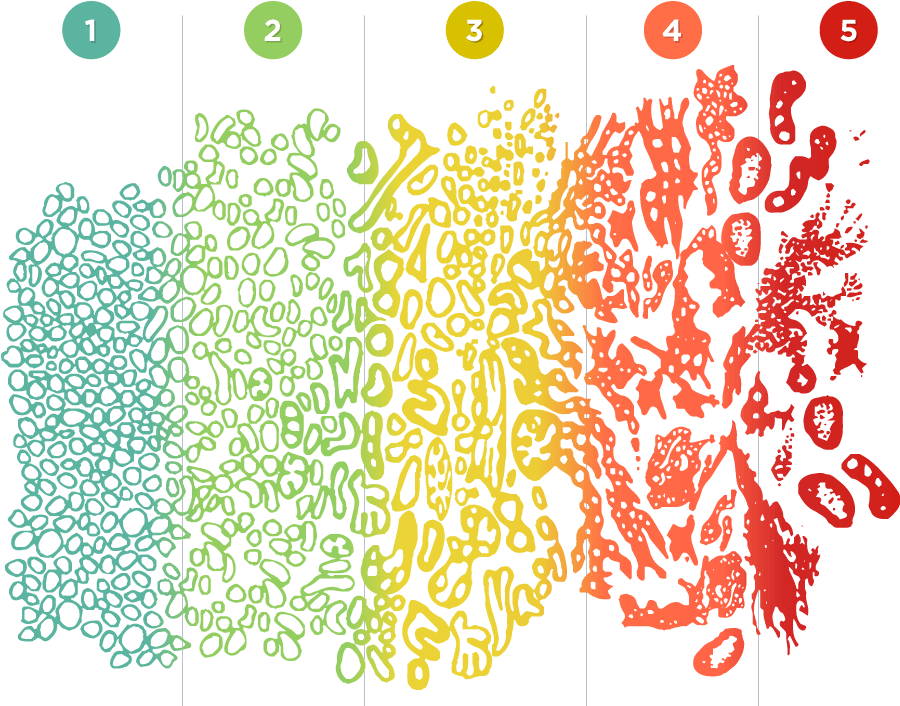What is the Gleason Grade?
What is the Gleason grade?
The Gleason grade is a numbering system that indicates the aggression level of prostate cancer cells. The sample cells are obtained by a needle biopsy of the prostate and examined under a microscope by a pathologist who assigns a grade (number value) to each sample. Gleason grades are ranked on a scale of 1-5, where 1 indicates least aggressive and 5 indicates most aggressive. Aggression means how fast the cancer is growing.
Gleason grade 1 – very low risk
Gleason grade 2 – very low risk
Gleason grade 3 – low risk
Gleason grade 4 – intermediate risk
Gleason grade 5 – high risk
The Gleason scale visualized
A Gleason score is reported as a sum of two grades (1 through 5), based on the two largest proportions of cancer seen in the biopsy needle samples. The graphic above represents a visualization of the prostate’s cellular makeup, ranging from healthy tissue (left) to developed cancer cells (right).
Gleason grade 1 indicates small, uniform glands of normal appearance.
Gleason grade 2 appears as larger glands with slight abnormalities and more space between them.
Gleason grade 3 has larger, irregular glands with more infiltrative space between them and cancer characteristics.
Gleason grade 4 shows highly irregular neoplastic glands with clumps of cancer cells present in the tissue.
Gleason grade 5 contains little to no gland formation with highly developed cancer cells in the tissue.
Note that Gleason grade 1 is never reported in a Gleason score since it indicates the cells are normal or very close to it. Similarly, Gleason grade 2 is only rarely reported.
What is the Gleason score, and why does it contain multiple numbers?
The Gleason score is always reported as a sum of two Gleason grade numbers. The numbers are taken from the two largest proportions of cancer seen in the biopsy needle samples. The grade assigned to the larger proportion is always reported first.
Chart of possible Gleason scores
| Gleason score | Explanation |
| Gleason 3+3 = 6 Low risk |
Indicates that the largest proportion found in a biopsy needle was a 3 (low risk) and the second largest proportion found was also a 3 (low risk). Gleason 3+3 is considered low risk. |
| Gleason 3+4 = 7 Low-to-intermediate risk |
Indicates that the largest proportion was a 3 (low risk) and the second largest was a 4 (intermediate risk). Gleason 3+4 is generally considered intermediate risk depending on other factors such as PSA and clinical stage. |
| Gleason score 4+3 = 7 Intermediate risk |
Indicates that the largest proportion was a 4 (intermediate risk) and the second largest was a 3 (low risk). Gleason 4+3 is more aggressive than Gleason 3+4 because there is a larger proportion of intermediate than moderately aggressive cancer |
| Gleason 4+4 = 8 Intermediate-to-high risk |
Indicates that the largest proportion found in a biopsy needle was a 4(intermediate risk) and the second largest proportion found was also a 4 (intermediate risk). Gleason 4+4 is generally considered high risk because of the large volume of Gleason 4 prostate cancer. |
| Gleason 4+5 = 9 Gleason 5+4 = 9 Gleason 5+5 = 10 High risk |
The presence of any Gleason 5 prostate cancer always indicates high risk disease. |
The Gleason score is used to help guide the most appropriate treatment choice(s), but it is not the only factor. Additional determinants may include patient age, PSA, tumor stage, family history, ethnicity, and genomic factors.
A New Grading System Using Grade Groups
The traditional Gleason grading system and the Gleason score as a sum of two numbers can be confusing for patients. For example, both Gleason score 3+4 and Gleason score 4+3 equal 7, so why is 3+4 considered lower risk than 4+3? To address the problem of confusion, in 2016 the World Health Organization accepted a new grading system using groups.
In this system, Grade Group 1 is the least risk, with Grade Group 5 the greatest risk.
A new grading system
- Grade Group 1 (Gleason score < 6) – Only individual discrete well-formed glands
- Grade Group 2 (Gleason score 3+4 = 7) – Predominantly well-formed glands with a lesser component of poorly-formed/fused/cribriform glands
- Grade Group 3 (Gleason score 4+3 = 7) – Predominantly poorly –formed/fused/cribriform glands with a lesser component of well-formed glands
- Grade Group 4 (Gleason score 8)
- Only poorly-formed/fused/cribriform glands or
- Predominantly well-formed glands with a lesser component lacking glands or
- Predominantly lacking glands with a lesser component of well-formed glands
- Grade Group 5 (Gleason scores 9-10) – Lacks gland formation (or with necrosis) with or without poorly-formed/fused/cribriform glands
Since 2016, doctors are gradually transitioning from the traditional Gleason score to the new grade group system, it is recommended that both systems be reported and explained to patients until the new system is widely practiced.
Concerned about your Gleason score?
Schedule a free consultation! Our specialists will work with you to review your unique profile and plan the best next steps for you.


